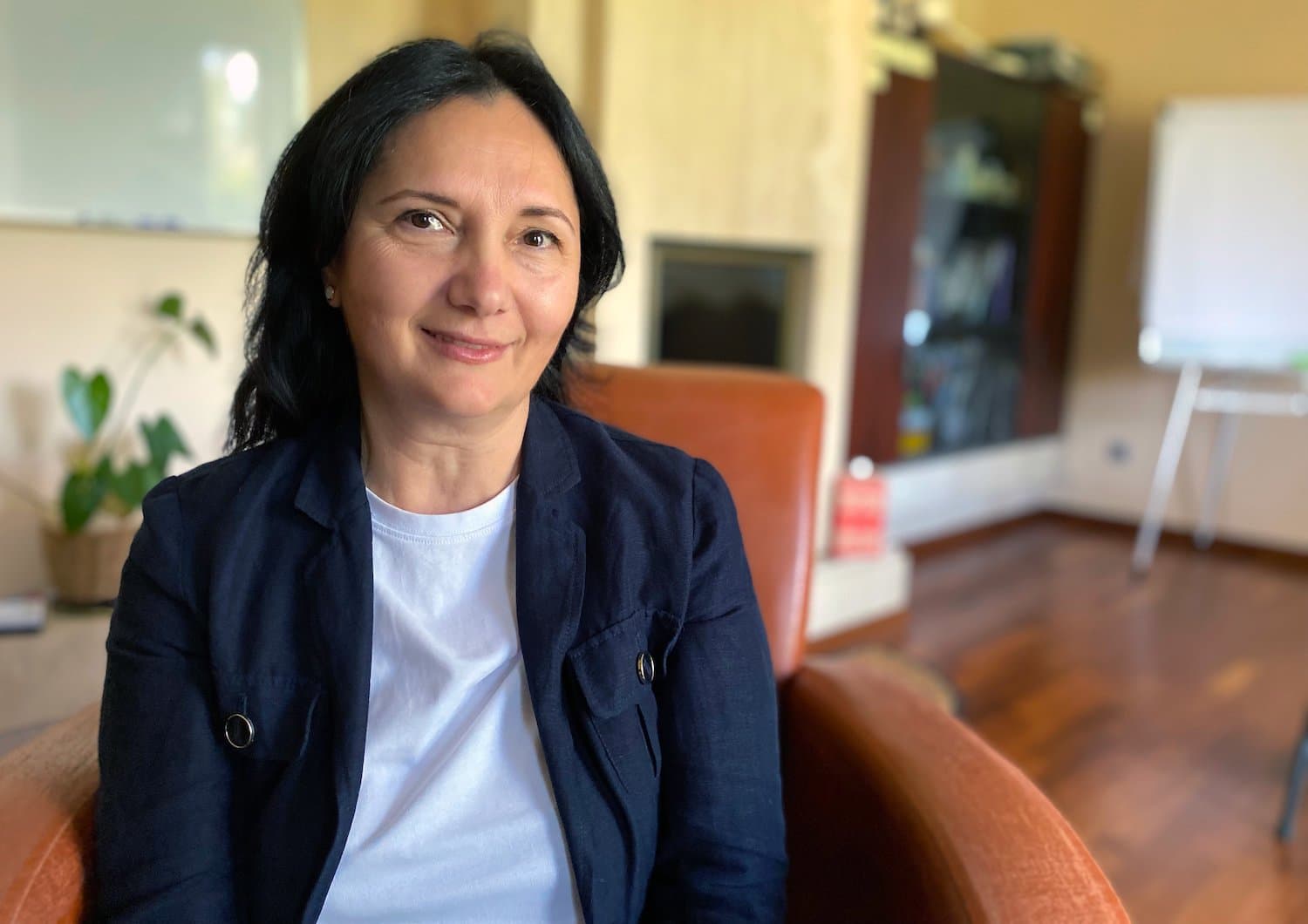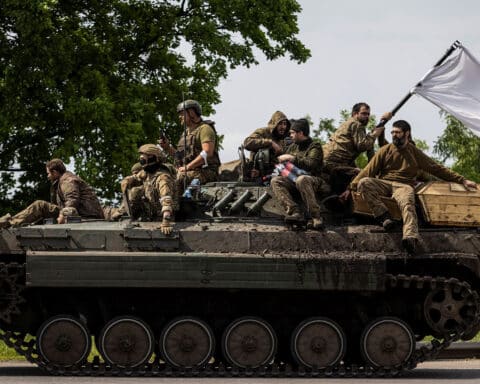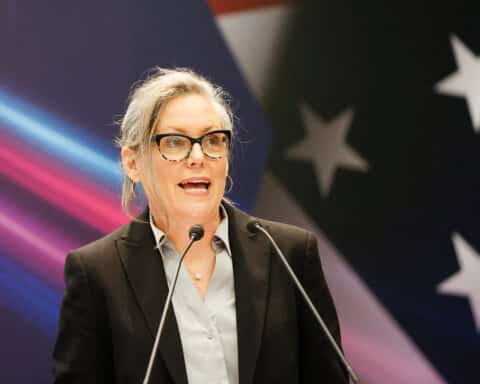LVIV, Ukraine (OSV News) — Inga Dul blushed slightly when giving OSV News a recent tour of her office, located on a leafy, elegant street in Lviv, Ukraine.
“This isn’t my style,” she apologized, pointing to the hallway’s ornate lighting fixtures and marble inlay, and joking that the original furniture was capped with gaudy “lion’s claw” ornaments.
But as the executive director for the Jesuit Refugee Service in Ukraine, Dul — speaking in Ukrainian through an interpreter — said she is grateful for the unexpected opulence.
That’s because the building, once the mansion of a wealthy businessman, has become a JRS home to some two dozen women and children — refugees within their own country who have fled Ukraine’s eastern provinces, which since 2014 have been ravaged by brutal Russian attacks that intensified exponentially with the February 2022 full-scale invasion.
Currently, there are an estimated 5.1 million individuals internally displaced within Ukraine, according to the International Organization for Migration, part of the United Nations network. More than 6.2 million Ukrainians have sought safety abroad since the start of the full-scale invasion. At least 2.5 million Ukrainians have been forcibly taken to the Russian Federation, and close to 19,600 children are being held in Russian “re-education” camps, with the actual number for the latter feared to be much higher. At least 100,870 war crimes by Russian forces in Ukraine have been documented since February 2022.
Daily life in Ukraine
For those who have remained in Ukraine, daily life is lived under the constant threat of drone and missile attacks, which routinely target civilian structures such as apartment buildings, residences, medical facilities, schools, shops and cultural centers. Russia’s June 6 destruction of the Kakhovka Hydroelectric Power Plant and reservoir, located in Ukraine’s Kherson region, flooded dozens of settlements.
While the western areas of the country have remained somewhat safer than the centrally located Kyiv and the nation’s south and east, 10 people were killed and 45 injured when Russia struck a residential building just blocks away from the JRS house July 6.
Dul and the JRS team are well accustomed to the nonstop trauma experienced by refugees from a variety of backgrounds.
The agency, which operates programs in 59 countries, came to Lviv in 2005 and opened the house that Dul manages in 2008, purchasing the property because of its proximity to the railway station, airport and immigration office. A second house in Khmelnitsky, located about 150 miles east of Lviv, hosts refugees en route to Poland.
Dul told OSV News that JRS also has rented another home in her village to accommodate several elderly people and women with very small children.
The first wave of refugees the Lviv house welcomed in 2008 were from “Afghanistan, Syria, Iraq, Iran, Somalia, Sudan, Palestine, Tajikistan, Russia and Chechnya,” Dul told OSV News.
When Russia launched its attacks against Ukraine in 2014, displaced persons from Crimea, Donetsk and Luhansk arrived. As Russian troops began amassing on Ukraine’s border with Belarus in 2022, JRS prepared for a new influx of refugees, stocking up on food, medical supplies, and alternative sources of heat and electricity.
Dul, an attorney first tapped by JRS as a deputy and then executive director of the Lviv house, said the common experience of refugees, regardless of their country of origin, is “constant fear.”
“If you have a bird that flies all the time and cannot settle or sit somewhere, it will die,” she said.
Home for families
For the pre-2014 wave of immigrants, JRS aimed to provide three to six months of stay, “a place for them to sit, to rest — home, safety and prayer” as they transitioned to their destination countries, said Dul.
After Russia’s February 2022 invasion, some of those refugees who had successfully resettled in the U.S. and Germany “found me on Facebook and started writing me, telling me, ‘We want to send you money. What can I do for you?'” said Dul. “They were Afghani and Iraqi people who had left this house 10 years ago, and they just wanted to help.”
That assistance was badly needed: in the first three months of the full-scale invasion, “600 people went through this house,” Dul said, noting that JRS’ years of established ministry in Ukraine enabled her and her team to handle the onslaught.
She personally canvassed area shelters to find the current residents of the Lviv house, seeking out in particular those whose children had disabilities.
Tanya, who came from Pokrovsk in the Donetsk region, said her two children, whom she brought to escape Russian shelling, “need medical help all the time.”
“My husband is still there because he has elderly parents, and he cannot leave them,” she explained in Ukrainian.
Another resident, who did not wish to give her name, told OSV News that after escaping their home near Bakhmut — where some of the war’s bloodiest battles have been waged — she and her children had lived for three months 13 to a room in one school building.
“Some people lived in the gym, and it was even worse,” she said. “But Inga would drive around the city, looking for children and moms to get them into this house.”
Each little family has its own private quarters in the house, with meals served in the community dining room and common areas for recreation.
“Here I can relax. I don’t fear that noise, those bombs,” another resident, speaking in English and declining to give her name, told OSV News. “It’s not the same like in those regions that are on the zero line (of the battles).”
“Our prayers surround us, thank God,” she added, her filling with tears.
Children are resilient but hurting
When not attending school, children at the Lviv home spend time playing, learning English and computer skills, and making crafts — including trench candles and tiny dolls for Ukrainian soldiers.
One of the little boys sent a doll to his father, currently fighting in the Armed Forces of Ukraine, said Dul.
“He wrote, ‘Father, it’s me, Zhenya. I made this doll for you to come back home earlier,'” she said.
While the kids at the house may seem upbeat and resilient, Dul is now seeing “psychological problems” starting to manifest themselves after more than a year and a half of the full-scale invasion.
“One of the girls just starts crying without any reason,” she said. “Another boy hides in the closet.”
She and her team are developing more psychological support resources for the residents and for the larger community, particularly as Ukrainians rebuild after the war.
As they await their eventual return to their own homes, residents have come to depend on Dul as a true “house mother.”
“We are like family here,” said Tanya. “Inga was at a conference for a week, and I was so glad to see her when she got back.”
“We are all mothers here,” said one resident. “We just want to have a future for our kids. Maybe not for us,” she said through tears. “But for their future.”





